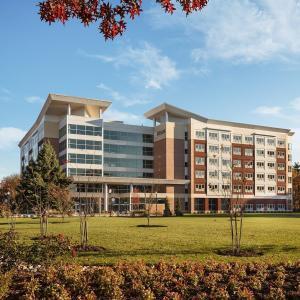A building’s performance and longevity depend significantly on the proper application of insulation. Sufficient insulation will slow heat transfer into and out of the building, save energy and money, and create a comfortable indoor environment.
Builders can choose from several insulation materials, including Expanded Polystyrene (EPS), Extruded Polystyrene (XPS), Mineral Wool, and Graphite Polystyrene (GPS). Understanding the features and benefits of each of the different insulations will help you choose the best high-performing product for your building project.
Graphite Polystyrene Insulation
Manufacturers produce graphite polystyrene insulation (GPS) like EPS, but with the infusion of high-purity graphite particles into the polystyrene beads, which creates Neopor beads. Neopor gives GPS insulation a dark gray appearance and a greater R-value (4.7) than traditional EPS insulation products. Builders can use GPS insulation on wood or steel frame construction.
Benefits and Features of GPS Insulation
- Increased Thermal Resistance: The graphite particles reflect and absorb radiant energy, which slows heat transfer and produces 18 percent more insulation capacity than EPS.
- Increased Board Strength and Flexibility: Manufacturers laminate the foam with a reflective film, which increases its strength and flexibility.
- Moisture Resistance: The reflective, micro-perforated laminated surfaces give the panel a high water vapor permeance (perm rating of up to 5.0), which reduces the chance of trapped moisture.
- Improved Job Site Efficiency: The larger panels and laminated film enhance job site efficiency and lessen labor costs.
- Design Flexibility: Manufacturers can form GP into many different shapes during manufacturing.
Sto GPS Board
Builders and architects can use Sto GPS Board in StoTherm® ci GPS and StoPowerwall® ci systems. It offers the following benefits and features:
- Energy Efficiency: Sto GPS Board provides continuous exterior insulation for reduced energy consumption and cost. The higher R-value than standard EPS allows for thinner wall sections.
- Sustainable: Sto GPS has lower global warming and zero ozone depletion potential due to their manufacturing process not using fluorocarbon-blowing agents (HFC, HCFC, or CFC). Recyclable GPS boards limit their environmental impact.
- Moisture Resistance: The water vapor semi-permeable of Sto GPS Board aids in drying water in walls.
Extruded Polystyrene (XPS) Insulation
Extruded polystyrene offers closed-cell insulation for interior and exterior walls for new construction and remodeling. The manufacturing of XPS insulation involves combining polystyrene crystals with additives and a gas-blowing agent. An extruding machine then mixes and melts the mixture into a thick liquid before processing it through a die. The die expands the liquid into foam, then shapes and trims it into rectangular or standard square boards.
Benefits and Features of XPS Insulation
XPS High Compressive Resistance
The high compressive strength (15-100 psi) of XPS insulation can withstand high pressure, so that it is able to withstand 6,144 lbs ft2 with a maximum deformation of 10 percent.
Sustainable
- Recyclable: 100-percent recyclable, which allows manufacturers to melt and reform the thermoplastic polystyrene resin into new XPS foam insulation.
- Energy-Efficient: XPS closed cell insulation gives it a high thermal resistance value to provide an R-value of 4.6 and 5.0, depending on their density, which makes it extremely energy efficient, to save energy in buildings and reduce CO2 emissions.
Moisture-Resistant
- Moisture-resistant XPS has an absorption rate of 0.3 percent to resist moisture infiltration during and after application. XPS insulation offers freeze-thaw resistance to protect the insulation’s thermal performance and to prevent damaging and unhealthy mold. The low permeability makes it perfect for laundry rooms and other high-moisture spaces.
Straightforward to Install
Simple to apply, lightweight XPS insulation does not irritate the worker’s skin.
StoTherm® ci XPS
Builders and architects can use StoTherm® ci XPS in residential or commercial wall construction where energy efficiency, superior aesthetics, and air and moisture control are essential in the climate extremes of North America. StoTherm® ci XPS is an EIFS with drainage and continuous insulation wall system that integrates the StoGuard® air and water-resistive barrier, XPS insulation, and drainage to produce the following benefits and features:
- Aesthetic Versatility: StoTherm®ci XPS can achieve various aesthetic appearances like brick, wood, stucco, concrete or stone using Sto textured finishes, Sto Specialty finishes, or StoCast surface components.
- Energy-Efficiency: StoTherm®ci XPS continuous exterior insulation achieves R-5 per inch with no mechanical fasteners to lower cooling and heating costs.
- Fast Installation: StoTherm®ci XPS provides quick-set adhesive, with no mechanical fasteners, decreasing thermal bridging.
- Moisture Resistance: StoTherm®ci XPS’s continuous air and water-resistive barrier protects against mold and moisture issues.
- Code Compliance: Fully tested building code compliant StoTherm®ci XPS assembly is ICC-ES listed and evaluated.
Expanded Polystyrene (EPS) Insulation
Lightweight expanded polystyrene (EPS) foam is a rigid, closed-cell wall insulation. EPS manufacturing involves expanding raw polystyrene beads with steam up to 50 times their volume. The beads go into a mold where steam and pentane further expand them to form a rectangular block.
Benefits and Features of EPS Insulation
High Compressive Strength
The compressive strength of EPS insulation ranges between 10 – 60 psi that increases with density.
The high compressive strength provides:
- Thickness recovery after excessive construction load exposures.
- Absorption of substrate irregularities.
- Absorption of the substrate and facing movement due to structural deflections and temperature changes.
- Sufficient subgrade reaction for effective load distribution.
Sustainable
- EPS does not contain toxic ozone chemicals like formaldehyde, hydrochlorofluorocarbon (HCFC), hydrofluorocarbon (HFC), and chlorofluorocarbon (CFC).
- EPS has a thermal resistant R-value of 3.6 to 4.2, which saves energy and money.
- You can recycle EPS.
Moisture-Resistant
- EPS boards are available in several densities to meet specific project needs, from 0.75 to 2.0 psi.
- The tightly packed cells stop voids, contributing to EPS’s moisture resistance and making it suitable for wet environments.
Installation Benefits
- EPS provides installation versatility by cutting quickly and accommodating unfinished interior and exterior walls for new construction and retrofits.
- EPS is lightweight and simple to apply.
Sto EPS Insulation Board
Builders can use StoTherm® ci in residential or commercial wall construction where energy efficiency, superior aesthetics, and moisture and air control are crucial.
Rigid cellular Sto EPS Insulation Board offers several benefits and features for use in StoTherm® ci Wall Systems, an EIFS with drainage continuous insulation wall system.
- Aesthetic Flexibility: Workers can easily cut, score, shape, and rasp lightweight Sto EPS insulation board.
- Energy-Efficient: EPS offers continuous insulation to achieve the required R-value or U-factor in wall construction when used in StoTherm® ci Systems.
- Long Lasting: Fully tested for fire exposure and durability in StoTherm® ci Systems.
- Code Compliance: Made by licensed Sto EPS Insulation Board molders per ASTM E2430 and ASTM C578 requirements for Type 1 EPS.
Mineral Wool Insulation
Mineral wool continuous insulation contributes to energy-efficient building design and non-combustible construction. Manufacturers typically use steel by-products (blast furnace slag) made of spent iron ore and limestone to make mineral wool.
Manufacturers melt slag and rock in cupola furnaces at over 2,600℉ (1426°C), then spin the molten lava into fibers using high-speed spinning wheels and compressed air. The manufacturing process produces mineral wool fibers that can withstand high temperatures, which gives them excellent fire-resistant properties. Builders can apply mineral wool continuous insulation behind non-combustible and combustible cladding types ranging from glass panels (opaque), EIFS, masonry veneer, resin cast shapes, metal panels, and fiber cement.
Benefits and Features of Mineral Wool
- Non-Combustible: Mineral wool insulation will not burn or release hot gasses and harmful smoke during a fire, which makes it a superior choice for multistory construction. Mineral wool in cavity walls and open-joint facade systems can significantly minimize fire spread across a building’s exterior wall surfaces.
The ASTM E119 test determines the fire performance of building materials based on fire temperature and time. It illustrates that mineral wool remains intact after five hours and temperatures over 2,000℉ (1093°C).
- Energy Efficient: Mineral wool insulation, with an R-value of 4.3 per inch, easily meets the specified R-value requirements of the ASHRAE 90.1 to prevent thermal bridging and create an effective R-value in a wall system. In addition, moisture exposure will not diminish mineral wool’s R-value, and declining temperatures cause mineral wool’s thermal conductivity to decrease, which enhances its R-value.
- Moisture Resistance: The engineering of mineral wool repels and drains moisture in continuous insulation applications. The design of mineral wool can handle driving rain, condensation, and other moisture on the wall system.
- Permeable: Air and vapor-permeable mineral wool CI (perm of 50) permits condensation/moisture/water within the wall cavity to dry towards the outside.
- Sustainable: Using slag allows mineral wool to achieve one of the industry’s highest recycled contents, which minimizes its environmental impact. After one month of use, one pound of mineral wool insulation saves the amount of energy used in its manufacturing.
- Sound Attenuation: Mineral wool products provide sound attenuation by absorbing and blocking sound between partition walls and floor/ceiling applications to enhance the indoor environmental quality for the structure’s occupants.
- Durability: Durable mineral wool repels water and resists UV rays, ice, rain, sleet, snow, and other weather-related events.
StoTherm® ci Mineral Wool Insulation
StoTherm® ci Mineral incorporates a high density non-combustible continuous exterior insulation and a continuous air and water-resistive barrier with Sto high-performance finishes to produce an advanced wall cladding system. Builders can use StoTherm® ci Mineral in residential or commercial wall construction.
The StoTherm® ci Mineral EIFS System offers the following features and benefits:
- Non-combustible, mineral wool exterior CI is a thermal control layer that resists fire and above 2000°F (1093°C).
- It is a continuous-seamless air, water, and vapor-resistant barrier from a single source.
- Sto high-performance finishes come in multiple textures and unlimited finish color selections.
- The Sto Thermo Dowel is a pre-assembled washer and fastener designed to minimize thermal conductivity.
- They include an EPS plug and can be countersunk and topped with a mineral wool cap to greatly minimize thermal bridging.
StoTherm® ci Mineral complies with vital fire standards for fire resistance and combustibility:
- ASTM E119: Maintains hourly fire resistance rating of non-load bearing steel frame concrete, concrete masonry wall assemblies.
- ASTM E84: Insulation has zero flame spread and smoke development.
- NFPA 285: System complies with requirements for use on all construction types without height limitation.
- NFPA 268: System does not ignite to radiant heat exposure and complies with mandates for use on all construction types without setback or height limitations.
- NFPA 220: Non-combustible insulation as defined by NFPA 220.
For more information on Sto systems and the various insulation options, contact a Sto professional today at (800) 221-2397 or via the website.


